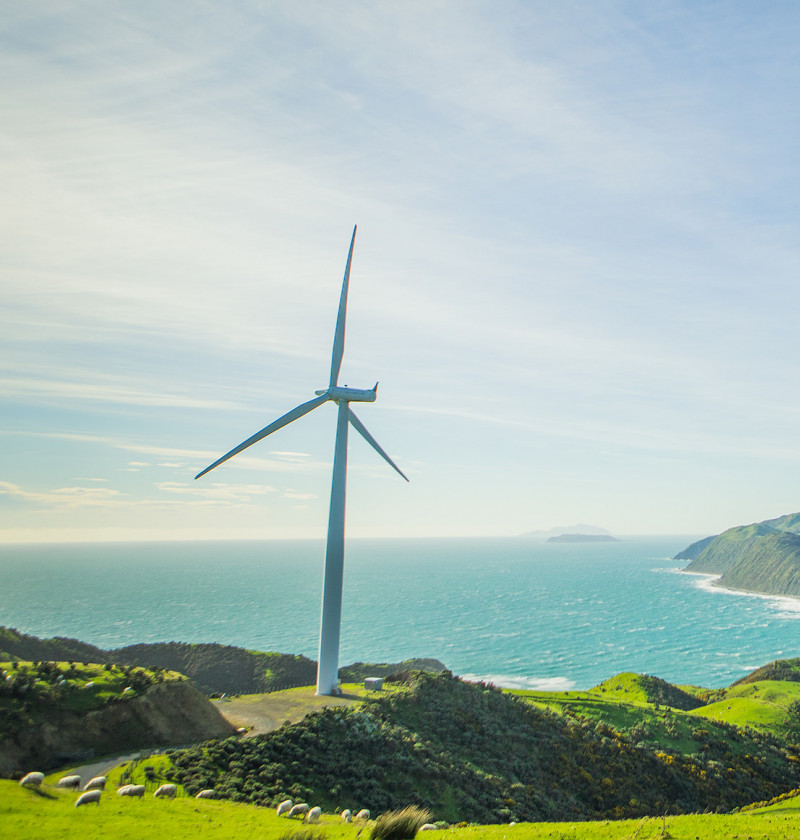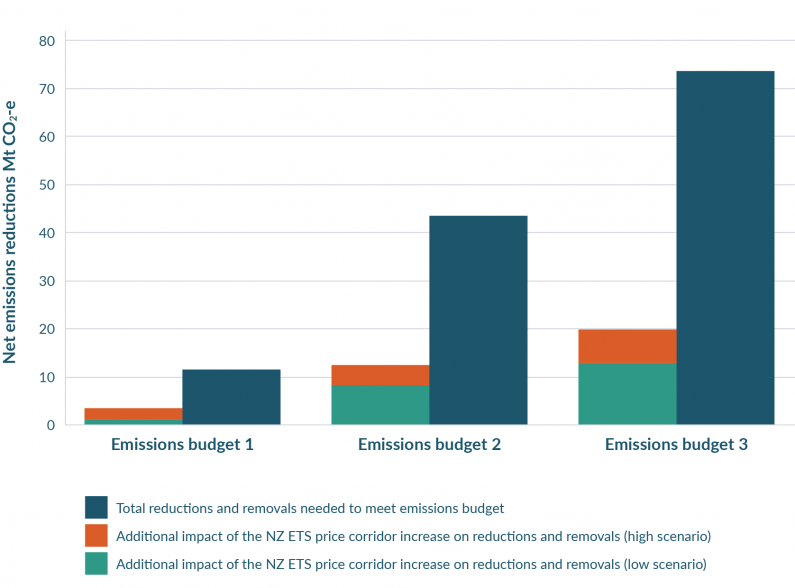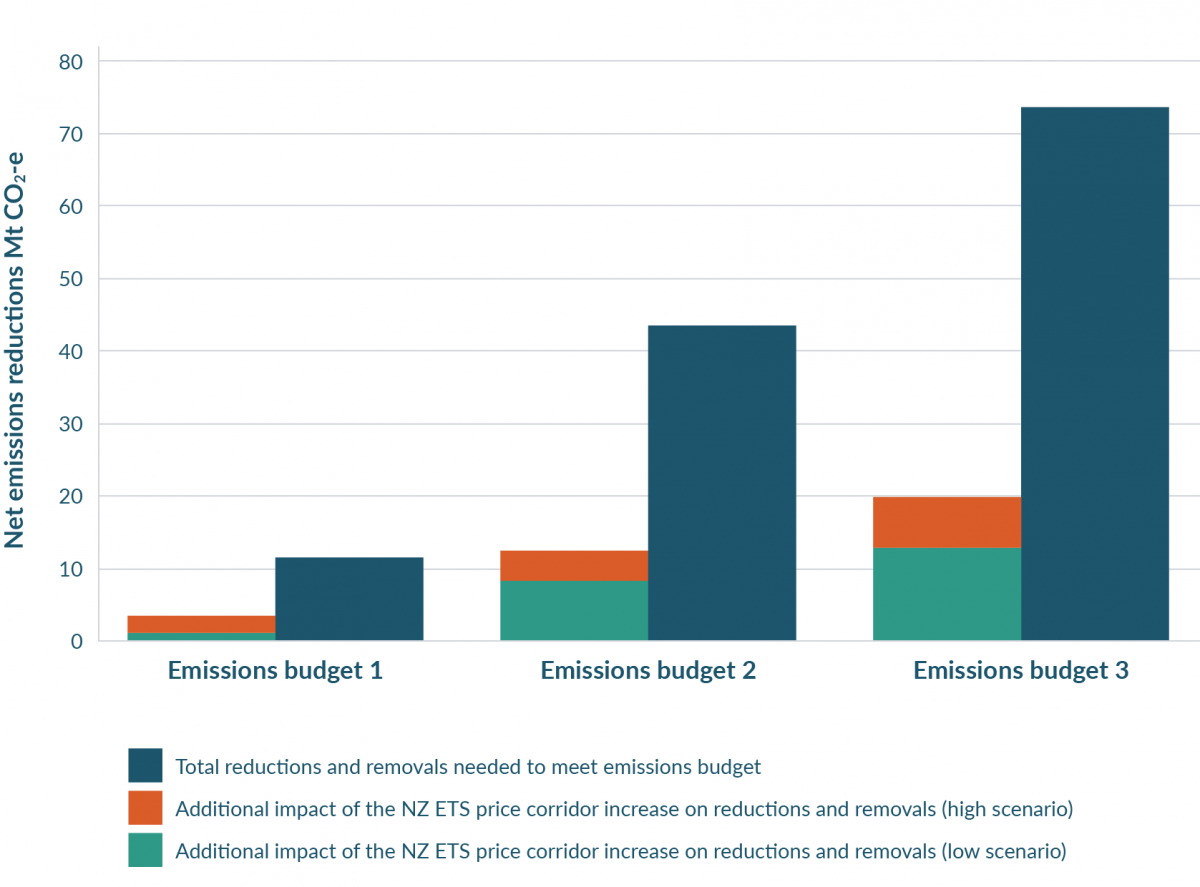Chapter 5 Emissions pricing

Download a PDF version of this chapter [PDF, 629 KB]
Emissions pricing provides a strong and stable signal of the cost of emissions to the economy. This will encourage climate mitigation across sectors and systems, the public sector and private sectors, businesses and households.
As we transition, emissions pricing will help drive businesses, households and the public sector to make low-emissions decisions. The New Zealand Emissions Trading Scheme (NZ ETS) is an economy-wide tool that incorporates the costs or benefits of greenhouse gas emissions and removals into day-to-day economic activity.
By aligning with successive emissions budgets and expectations of an increasing emissions price, the NZ ETS supports flexible decision making – empowering businesses and individuals to make decisions that are appropriate for their unique situations.
Emissions pricing is an economy-wide* tool that supports businesses, households and the public sector to incorporate the costs of emitting or the benefits of reducing or removing emissions into day-to-day decisions. Through a strong and stable price signal, emissions pricing provides a clear, consistent signal across the economy of the cost of emissions or the relative benefit of lower-emissions choices or investing in removals like forestry.
Our primary emissions pricing tool is the New Zealand Emissions Trading Scheme (NZ ETS). Aligning the NZ ETS with decreasing emissions budgets, along with expectations of a rising emissions price, allows it to shape future economic development by flexibly encouraging businesses and households to align investment decisions and choices with low-emissions alternatives.
* Except for the agriculture sector and a portion of the waste sector.
The NZ ETS creates a price signal by setting a ‘cap’ – or limit – on emissions and letting participants purchase, earn and trade permits for the right to emit (New Zealand Units or NZUs). Over time, the cap will decrease in line with emissions budgets, reducing the supply of NZUs available for auctioning and driving up the incentive for emissions abatement.
While upstream emitters (such as fuel importers) are responsible for paying NZUs, businesses and households still feel an emissions price through the increased cost of goods and services.
While emissions pricing plays a central role in reducing our gross and net emissions, emissions pricing alone cannot support our transition in an equitable way. A high reliance on emissions pricing without complementary measures would fail to achieve many low-cost emissions reduction opportunities due to the presence of other barriers. This approach would be unlikely to enable us to meet our climate goals and is considered to have the highest economic cost. Instead, a mix of regulation and policies, such as innovation, equitable transition measures, behaviour change and finance, are needed alongside emissions pricing. These are set out in this emissions reduction plan.
For example, this plan sets out the actions we are taking now to support the development, commercialisation and uptake of low-emissions technologies and products that could be incentivised by emissions pricing in the future.
Targeted and sector-specific policies will also help unlock future reductions and removals opportunities by providing early-stage support for new products and services.
Targeted policies can also help address the impacts of our transition from a broader wellbeing perspective. This includes ensuring businesses and households with historically less access to low-emissions alternatives can shift their behaviour as emissions prices rise.
For example, the Government and local government need to ensure there are affordable and accessible low-emissions transport options available for households who are impacted by higher fuel prices.
The impacts of emissions pricing and the resulting investment decisions and behaviour change will vary across sectors of the economy, regions and communities. Some communities will be more vulnerable to an increasing emissions price than others, particularly where access to low-cost or effective alternatives are limited.
As the emissions price rises, in line with our increasing climate ambition, targeted policies to support vulnerable communities and ensure an equitable transition will be required. This includes Māori communities – who typically have higher representation in lower income households – and may need support to adapt to the increasing emissions price.
The Government is committed to mitigating the impacts of a rising emissions price alongside other impacts on businesses, households and communities through other aspects of our transition (see chapter 11: Energy and industry, chapter 10: Transport, chapter 3: Equitable transition, chapter 2: Empowering Māori).
The 2021 update of the NZ ETS price control settings and the recent forestry proposals to restrict permanent exotic forests (if implemented) are estimated to result in a total of:
Most of this additional mitigation comes from the energy and industry sector, with a moderate amount from transport. The impact of the actions set out in this chapter on emissions has not yet been quantified.


The NZ ETS has recently been strengthened to include an overall ‘cap’ on emissions, in line with our emissions budgets and 2050 targets, and an auctioning system. To ensure the NZ ETS can continue to deliver a strong and stable signal over the long-term, the Government is planning the following actions.
The NZ ETS has a flexible cap that enables the volume of emissions within the scheme to be aligned with our emissions budgets. This alignment is primarily achieved through adjustments to the units available for auctioning.*
The Government is also required to set annual price controls for NZ ETS auctions: a ‘price floor’ and a ‘price ceiling’. These controls signal the bounds of acceptable NZU prices at auction and act as a safety valve if an auction’s clearing price deviates outside these bounds.** They also provide some certainty to businesses and investors on the future trajectory of NZU prices to aid the forecasting of emissions obligations, or to help with investment planning.
* Auction unit volumes are publicly available and the Government must update them each year to ensure at least five years of published unit volumes are always available.
** These bounds of acceptable NZU prices at auction are not intended to explicitly control the auction price; rather, the bounds moderate that price by adjusting unit supply. While the price at which units sell at auction will influence the secondary market price, supply and demand of NZUs at a point in time is the primary factor that determines the price at which NZUs sell.
In order to ensure the NZ ETS settings align with emissions budgets, He Pou a Rangi – Climate Change Commission will provide advice on the unit limit and price control settings for 2023–27. Once the advice has been received, the Government will:
He Pou a Rangi – Climate Change Commission has recommended that the Government consider how the NZ ETS may be amended to provide more robust support for gross emissions reductions, alongside enduring support for emissions removals through forestry. To ensure that the NZ ETS sends a strong, clear price signal that incentivises the right balance of gross and net emissions reductions, the Government will be looking into NZ ETS unit supply and what changes, if any, should be made to the NZ ETS to support this outcome.
There are a number of aspects to the NZ ETS that impact unit supply including industrial allocations, the current stockpile of NZUs, rates of afforestation and deforestation, and the number of NZUs being auctioned.
Further policy analysis is underway on unit supply in the NZ ETS to assess whether additional NZ ETS changes are needed to balance gross and net reductions.
Emissions removals other than from forestry activities could help remove emissions from the atmosphere and help achieve our climate goals. Non-forest activities such as restoring peatlands, riparian zones and shrubland are possible options, however, the NZ ETS does not currently accommodate their voluntary inclusion.
Emissions from these activities can be included in Aotearoa New Zealand’s Greenhouse Gas Inventory but require resourcing to build a credible evidence base with environmental integrity.
Direct air carbon capture and other activities that are not land-based (such as ocean marine blue carbon initiatives) are also possible options. To be accommodated in the NZ ETS, however, these removal types need to be included in Aotearoa New Zealand’s Greenhouse Gas Inventory. This would require a comprehensive evidence base and – if possible – sufficient international guidance.
The impact that new emissions removal categories have on Aotearoa New Zealand’s total net emissions will be considered as part of the Government’s policy analysis on unit supply in the NZ ETS.
The Government will investigate the feasibility of including other forms of emissions removals beyond forestry in New Zealand’s Greenhouse Gas Inventory and the NZ ETS.
While the NZ ETS is an economic tool used to price emissions, it should be consistent with Government’s biodiversity objectives and support indigenous afforestation. A suite of policies and incentives would be required to achieve this objective and the NZ ETS would likely play a supporting role.
The Government would need to ensure that any incentive for indigenous biodiversity does not undermine the scheme’s primary function to provide a strong and stable emissions price signal to the Aotearoa economy. For more detail on indigenous biodiversity initiatives, see chapter 14: Forestry and chapter 4: Working with nature.
The Government will investigate how indigenous biodiversity could be supported by the NZ ETS, including supporting long-term indigenous carbon sinks.
Aotearoa New Zealand’s recently updated Nationally Determined Contribution (NDC)* prioritises domestic emissions reductions and removals. However, achieving it will also require some offshore mitigation. The role the NZ ETS will play in meeting the NDC needs consideration to ensure it effectively and efficiently complements progress to meet our domestic emissions budgets and does not undermine the balance of gross and net emissions reductions determined by action 5.2.1.
* The Government recently increased Aotearoa New Zealand’s NDC (NDC1) to a 50 per cent reduction of net emissions below gross 2005 levels by 2030.
The Government will assess what ongoing role the NZ ETS should play in supporting our NDC and whether that role requires design changes.
The Climate Change Response Act 2002 establishes the legal framework for the implementation, operation and administration of the NZ ETS. It does not provide an overarching framework for its governance. Governance responsibilities are currently fragmented across agencies, and the lack of an overarching framework gives rise to significant advice, trading and market conduct risks.
Developing an overarching governance framework will help to ensure the NZ ETS is able to play an effective role over the course of our long-term transition.
Read more about market governance and its recent consultation
Emissions leakage is where firms, production, or investment move offshore to countries with weaker climate policy to avoid or reduce climate compliance costs in New Zealand.*
In Aotearoa, this risk is currently managed through industrial allocation policy, through which the Government freely allocates NZUs to activities considered at risk of emissions leakage.** The free allocation of units can be used to offset emissions-related costs, thereby reducing the risk that New Zealand firms will shift offshore.
However, current industrial allocation policy settings are contributing to over-allocation – where the Government provides eligible industries with more NZUs than necessary to reduce the risk of emissions leakage. In some instances, industries receive more than 100 per cent of their emissions costs.
* Additionally, global emissions may increase if this economic displacement is to countries that have no cap on emissions, or if the production is more emissions intensive than domestic production.
** Activities considered at risk of emissions leakage have a significant emissions intensity and are exposed to international trade.
Read more about the review of industrial allocation and its recent consultation
The Government will look at the long-term direction of how we manage the risk of emissions leakage in Aotearoa. One possible alternative is a carbon border adjustment mechanism that is currently being explored by the European Union.
In addition to the price paid through NZ ETS obligations, strong global – and local – trends are driving businesses and households to reduce their emissions voluntarily.
Currently, the Government publishes guidance that provides principles and good practice guidelines for claims of voluntary climate change mitigation made by business and organisations in Aotearoa. The guidance was last updated in early 2022.*
* Interim guidance for voluntary climate change mitigation [PDF, 442 KB]
The Government will develop a voluntary carbon market policy framework of rules and guidance to support the growing voluntary carbon market in Aotearoa. This work is being planned now and Cabinet will consider the next steps to deliver it in November 2022.
Additional actions contained in other chapters will support emissions pricing to further drive climate ambition.

Chapter 5 Emissions pricing
May 2022
© Ministry for the Environment